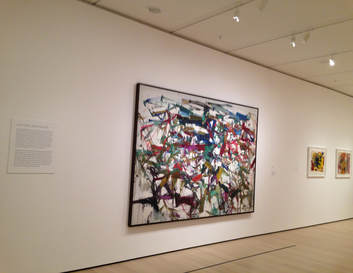 Joan Mitchell's "Ladybug" Joan Mitchell's "Ladybug" Making Space: Women Artists and Postwar Abstraction, a temporary exhibit at the Museum of Modern Art in New York City, brings together the works of more than 50 artists to illustrate the contribution of women artists to modern art. The works come from the Museum's collection. Following World War II, the art establishment became dominated by abstract art. Although the artistic community at the time regarded itself as avant garde and progressive, it was not very tolerant of competing ideas. For example, the doors of the galleries were closed to artists working in more traditional or realist styles. So too, the galleries - - and too often the minds of the art world - - were largely closed to women artists even those doing abstract work. In the post war period, there were few, if any, mutual support groups for women artists. Watching my mother's struggle (see Art of Valda), what help she received seemed mostly to come from male artists who she had met while at the Art Students League of New York. Thus, for a woman artists to become recognized during this period was very much an act of individual achievement. This exhibit brings together the works of a number of woman artists who managed to overcome the prejudice of the time. It documents that women indeed contributed to the various schools of abstraction that dominated this period. Although the exhibit presents these works as works of women artists, it is important to note that these artists did not identify themselves as women artists and were not just competing against other women. The goal was to be artists who produced art that would compete in the marketplace of ideas with all other art regardless of the sex of the person who produced it. Perhaps the best known school of abstraction at the time was Abstract Expressionism. The enormous drip paintings of Jackson Pollock are hallmarks of this school. It was widely believed that such monumental works required masculine strength and gestures. However, the exhibit documents that women artists were producing similar works on a large scale. These artists included Lee Krasner, the wife of Jackson Pollock, who is represented in this exhibit by her work “Graea.” The curves of paint in this work have an almost floral, organic look. Abstract expressionism is about emotions and the work I found that evoked more reaction in me was Joan Mitchell's “Ladybug.” I found the color combinations visually pleasing and the lines moving and exciting. I also was impressed by Helen Frankenholer's “Trojan Gates.” Although a large canvas, it seemed more cohesive and unique in its approach than many abstract expressionist pieces. At the opposite end of the spectrum is “Reductive Abstraction.” Here, the idea was to remove the human touch from the work. In the 1950s and 1960s, there was much talk about human isolation and the potential that the mindless application of science would create a sterile environment in the future. Accordingly, some artists created futuristic works based upon mathematical or scientific concepts that were devoid of the human touch. Jo Baer's “Primary Light Group: Red, Green and Blue” is made up of three canvases, each of which is primarily a blank white square. Around the outer edge of each of the squares is a narrow black border. The three canvases differ only in that on one there is the color of the narrow space between the white area and the border. On one it is red; one, it in green; and one it is blue. The concept relies on the work of physicist Ernst Mach on the optical effects of placing colors next to black. I found the work too devoid of emotion. In addition, it reminded me of the demonstrations in high school science class when the teacher would illustrate some principle by using a clever but meaningless gimmick. The exhibit also shows that women artists made contributions in bringing abstraction to textiles. Vera Neuman's “Stone on Stone” made in the 1950s appears to be a forerunner of the designs used in the fashion revolution of the 1960s. A more disquieting work is Magdalena Abakanowicz's “Yellow Abakan,” a large, rumpled piece of fiber that hangs on the wall like the corpses in a butcher's freezer. It is not pretty but it evokes emotion. Finally, the exhibit concludes with Eccentric Abstraction.” These are works where the artist used materials not traditionally used in making art. The challenge in such works is to add enough creativity to the project so that it becomes a work of art rather than a pile of junk. Lee Bonteciu's “Untitled” employs pieces of used canvas conveyor belts to form a swirling, three dimensional object. Its industrial coloring gives it a dark, foreboding feel. Once again, it is not pleasant looking but it is evocative of emotion. Comments are closed.
|
AuthorRich Wagner is a writer, photographer and artist. Archives
November 2018
Categories
All
|
 RSS Feed
RSS Feed